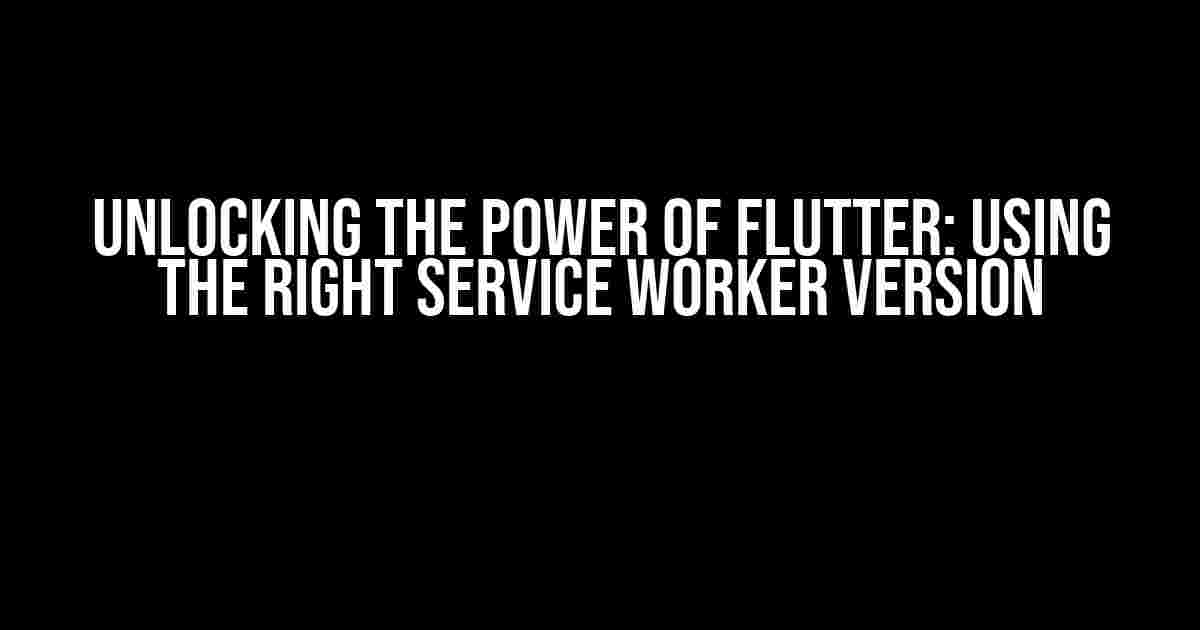Are you tired of encountering errors and inconsistencies in your Flutter application? Do you want to ensure a seamless user experience and optimized performance? Look no further! In this comprehensive guide, we’ll dive into the world of Flutter service workers and explore the importance of using the correct version. Specifically, we’ll discuss the magic of the “{{flutter_service_worker_version}}” template token and how it can revolutionize your development workflow.
What is a Service Worker?
A service worker is a script that runs in the background, allowing you to manage network requests, cache resources, and provide offline support for your web application. In the context of Flutter, service workers play a crucial role in handling HTTP requests and responses, making them essential for a smooth and efficient user experience.
The Importance of Versioning
In the world of software development, versioning is crucial. It ensures that different components of your application are compatible and work together seamlessly. When it comes to service workers, using the correct version is vital to avoid conflicts and errors. This is where the “{{flutter_service_worker_version}}” template token comes into play.
Understanding the “{{flutter_service_worker_version}}” Template Token
The “{{flutter_service_worker_version}}” template token is a powerful tool that allows you to dynamically inject the correct service worker version into your Flutter application. This token is automatically replaced with the latest version of the service worker during the build process, ensuring that your application always uses the most up-to-date and compatible version.
How to Use the “{{flutter_service_worker_version}}” Template Token
To use the “{{flutter_service_worker_version}}” template token, simply replace the hardcoded version number in your FlutterLoader.load() function with the token. For example:
FlutterLoader.load({
// Instead of hardcoding the version number, use the template token
serviceWorkerVersion: '{{flutter_service_worker_version}}',
onFlutterReady: () => {
console.log('Flutter is ready!');
},
});Benefits of Using the “{{flutter_service_worker_version}}” Template Token
So, what are the benefits of using the “{{flutter_service_worker_version}}” template token?
- Automated Version Management: With the template token, you don’t need to worry about keeping track of the latest service worker version. The token takes care of it for you, ensuring that your application always uses the most up-to-date version.
- Reduced Errors and Conflicts: By using the correct service worker version, you can avoid errors and conflicts that can arise from using outdated or incompatible versions.
- Improved Performance: The latest service worker version often includes performance optimizations and bug fixes, which can significantly improve the overall performance of your Flutter application.
- Simplified Development Workflow: With the template token, you can focus on developing your application without worrying about versioning issues. This simplifies your development workflow and reduces the risk of errors.
While using the “{{flutter_service_worker_version}}” template token is a straightforward process, you may encounter some common issues. Here are some solutions to help you overcome them:
| Issue | Solution |
|---|---|
| Hardcoded version number | Replace the hardcoded version number with the “{{flutter_service_worker_version}}” template token. |
| Version conflicts | Ensure that all dependencies are up-to-date and compatible with the latest service worker version. |
| Service worker not updating | Check that the service worker is properly registered and updated during the build process. |
Best Practices for Service Worker Management
To get the most out of your service worker and the “{{flutter_service_worker_version}}” template token, follow these best practices:
- Keep Your Dependencies Up-to-Date: Ensure that all dependencies, including the service worker, are up-to-date and compatible with each other.
- Use the Latest Flutter Version: Stay on top of the latest Flutter releases to take advantage of new features, bug fixes, and performance optimizations.
- Test Thoroughly: Test your application thoroughly to identify and resolve any issues that may arise from service worker versioning.
- Monitor Performance and Errors: Keep an eye on your application’s performance and error logs to quickly identify and address any issues related to service worker versioning.
Conclusion
In conclusion, using the “{{flutter_service_worker_version}}” template token is a game-changer for Flutter developers. It simplifies the process of managing service worker versions, reduces errors and conflicts, and ensures that your application always uses the latest and greatest version. By following the best practices outlined in this guide, you can unlock the full potential of your Flutter application and provide a seamless user experience.
So, what are you waiting for? Start using the “{{flutter_service_worker_version}}” template token today and take your Flutter development to the next level!
Here are 5 Questions and Answers about “Use `{{flutter_service_worker_version}}` template token instead. // FlutterLoader.load”
Frequently Asked Question
Get answers to your questions about using the `{{flutter_service_worker_version}}` template token and FlutterLoader.load!
What is the purpose of using `{{flutter_service_worker_version}}` template token?
The `{{flutter_service_worker_version}}` template token is used to fetch the latest version of the Flutter service worker, ensuring that your Flutter app is always up-to-date with the latest features and bug fixes.
Why should I use `{{flutter_service_worker_version}}` instead of hardcoding the version number?
Hardcoding the version number can lead to outdated versions being used, which can cause compatibility issues and bugs. Using `{{flutter_service_worker_version}}` ensures that you always get the latest version, without having to manually update the version number.
What happens if I don’t use `{{flutter_service_worker_version}}` and instead hardcode the version number?
If you hardcode the version number, your app may not receive the latest updates and bug fixes, which can lead to compatibility issues, errors, and a poor user experience. It’s always best to use `{{flutter_service_worker_version}}` to ensure you’re getting the latest and greatest version of the Flutter service worker!
Can I use `{{flutter_service_worker_version}}` with other Flutter plugins and libraries?
Yes, you can use `{{flutter_service_worker_version}}` with other Flutter plugins and libraries. The token is designed to work seamlessly with other Flutter dependencies, so you can rest assured that your app will always be up-to-date and running smoothly.
Is using `{{flutter_service_worker_version}}` a best practice for Flutter development?
Absolutely! Using `{{flutter_service_worker_version}}` is a best practice for Flutter development, as it ensures that your app is always up-to-date and takes advantage of the latest features and bug fixes. It’s a simple yet powerful way to keep your app fresh and running smoothly!
